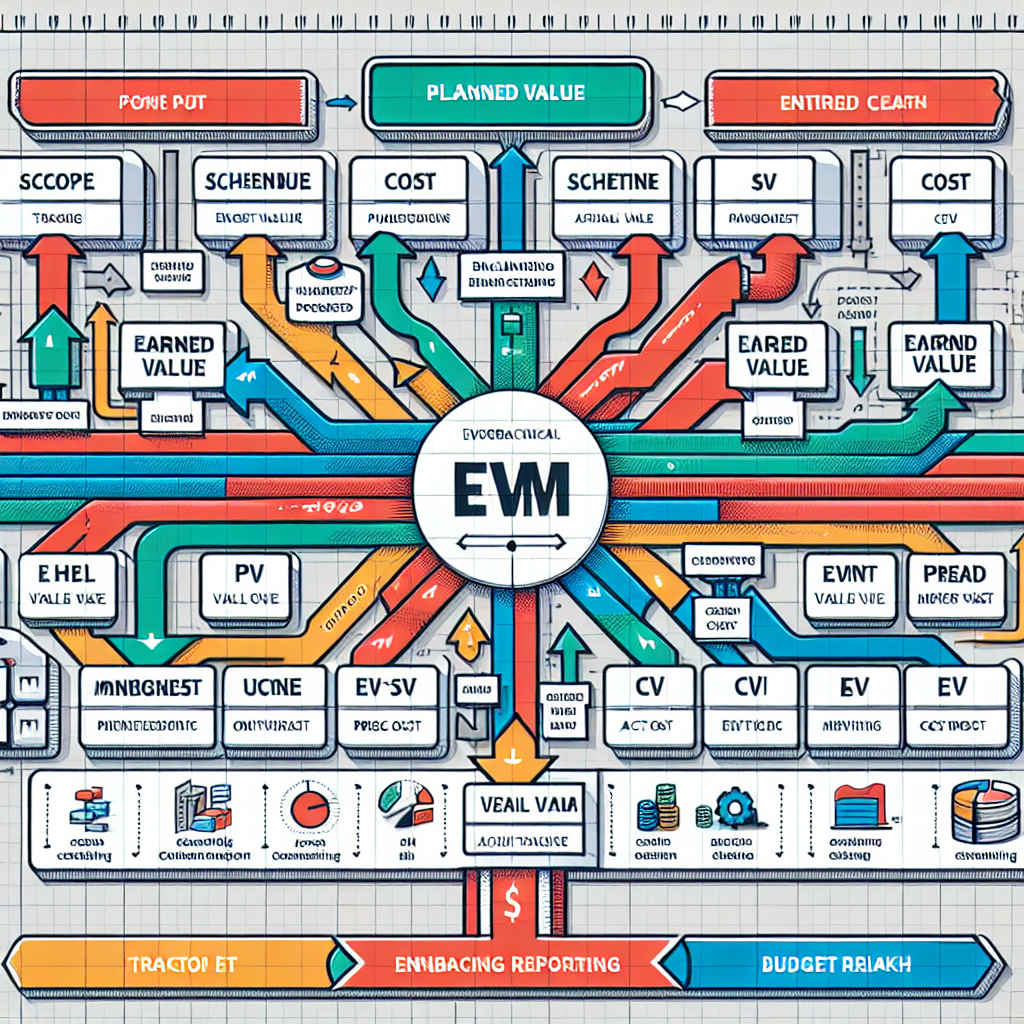Earned Value Management (EVM) is a powerful project management tool that integrates scope, schedule, and cost dimensions to assess project performance and progress objectively. By quantifying work accomplished against planned efforts, EVM enables project managers to identify variances and forecast future performance, ensuring projects stay on track and within budget. This article delves deep into the significance of EVM, its core components, detailed earned value calculation methods, and essential earned value formulas. We’ll also explore the practical applications of EVM in project controls, providing you with vital insights to effectively manage and steer your projects to successful completion.
What is Earned Value Management (EVM)?
Earned Value Management (EVM) is a systematic project management approach used to measure project performance and progress. By blending scope, schedule, and cost metrics, EVM allows project managers to assess the current status and predict future trends of a project accurately. It offers a quantitative method to gauge the amount of work completed against what was planned, making it easier to identify discrepancies early. Utilizing EVM not only aids in keeping projects within budget and on schedule but also enhances decision-making by providing concrete data that highlight areas needing attention. Essentially, EVM turns subjective project assessments into objective, data-driven evaluations.
Importance of Earned Value Management in Projects
In the realm of project management, Earned Value Management (EVM) stands out as a critical system due to its ability to unify multiple project dimensions into a coherent framework for analysis and action. By offering a quantifiable measure of project performance, EVM aids project managers in pinpointing deviations from the plan at an early stage. This early detection is invaluable because it allows for proactive issue resolution, minimizing the potential for budget overruns and schedule delays. Furthermore, EVM enhances communication among stakeholders by providing clear, objective data on project status, fostering transparency and informed decision-making. Integrating EVM into project management practices not only boosts the likelihood of project success but also builds a foundation for future project process improvements, driving overall organizational growth and efficiency.
Key Components of Earned Value Management
In Earned Value Management, several critical components form the backbone of the system, allowing for systematic tracking and analysis of project performance. One of the core elements is the Planned Value (PV), which represents the budgeted amount for the work scheduled to be completed by a specific date. Another vital component is the Earned Value (EV), reflecting the value of work actually performed to date, measured in terms of the budget allocated for that work. The third essential metric is the Actual Cost (AC), indicating the amount spent on the project thus far.
These components provide the foundation for calculating two critical performance indicators: Cost Performance Index (CPI) and Schedule Performance Index (SPI). CPI is determined by dividing EV by AC, offering insights into cost efficiency. SPI, on the other hand, is calculated by dividing EV by PV, providing an indication of schedule adherence. By combining these components and indicators, project managers can obtain a holistic view of project health, pinpoint areas of concern, and implement corrective measures proactively.
How to Calculate Earned Value (EV)?
Calculating Earned Value (EV) is a crucial step in applying Earned Value Management. The process involves determining the value of work actually performed based on the project’s performance measurement baseline. To calculate EV, you must multiply the percentage of completed work by the project’s total budget – also known as the Budget at Completion (BAC). Accurate EV calculation requires regular assessment and consistent tracking of project progress against the anticipated schedule and allocated budget. This metric helps in identifying deviations early, allowing timely corrective actions to keep the project aligned with its goals.
Detailed Example of Earned Value Calculation
To illustrate the practical application of Earned Value Management, let’s consider a project with a total budget of $200,000 and a planned duration of 10 months. By the end of Month 5, the project has completed 50% of planned work but has spent $120,000. Using EVM metrics, we will calculate the key indicators such as Planned Value (PV), Earned Value (EV), and Actual Cost (AC). In this example, PV at Month 5 would be $100,000, EV would also be $100,000, and AC is $120,000. These metrics will enable us to determine the Schedule Performance Index (SPI) and Cost Performance Index (CPI), providing a clear view of the project’s health and helping forecast future performance. This case will offer a comprehensive understanding of how EVM helps in scrutinizing project progress and making informed decisions.
Understanding Earned Value Formulas
The core of Earned Value Management lies in its precise formulas, which allow project managers to measure performance and predict project outcomes with accuracy. Understanding these formulas is essential for interpreting EVM data and making informed decisions. This section will cover fundamental metrics such as Planned Value (PV), Earned Value (EV), and Actual Cost (AC), as well as performance indices like Cost Performance Index (CPI) and Schedule Performance Index (SPI). By mastering these calculations, you can gain a clearer picture of project health and efficiency, enabling proactive management and timely interventions to keep projects aligned with their objectives.
Schedule Variance (SV) and Cost Variance (CV)
Schedule Variance (SV) and Cost Variance (CV) are fundamental metrics within Earned Value Management (EVM) that provide critical insights into project performance. SV measures the difference between the value of work actually performed and the value of work scheduled to be performed at a certain point in time, helping project managers understand time-related discrepancies. Positive SV indicates the project is ahead of schedule, while negative SV suggests delays.
On the other hand, CV quantifies the financial aspect by comparing the budgeted cost of work performed against the actual cost incurred. Positive CV signifies that the project is under budget, whereas negative CV points to budget overruns. Together, SV and CV enable a comprehensive evaluation of project health, facilitating proactive management and corrective actions to ensure successful delivery.
Schedule Performance Index (SPI) and Cost Performance Index (CPI)
The Schedule Performance Index (SPI) and Cost Performance Index (CPI) are vital metrics in Earned Value Management, offering insights into project efficiency both in terms of time and cost. SPI measures how efficiently the project is adhering to the planned schedule by comparing the earned value to the planned value. A value greater than 1 indicates the project is ahead of schedule, while a value less than 1 signifies it is behind schedule.
Conversely, the CPI assesses cost efficiency by comparing the earned value to the actual costs incurred. A CPI value greater than 1 denotes that the project is under budget, showcasing effective cost management, whereas a value below 1 indicates overspending. By regularly monitoring these indices, project managers can make data-driven decisions to correct deviations and optimize resource allocation, ensuring the project’s successful and cost-effective completion.
Estimating to Complete (ETC) and Estimate at Completion (EAC)
Estimating to Complete (ETC) and Estimate at Completion (EAC) are crucial metrics in Earned Value Management (EVM) that help project managers determine future costs and predict the total project expenditure at completion. ETC refers to the expected cost needed to finish all remaining work on a project, providing insights into the budget required from the current point forward. EAC, on the other hand, forecasts the total cost of the project upon completion, combining the actual cost incurred to date with the ETC. By utilizing these metrics, project managers can make informed decisions, reallocate resources, and implement corrective measures to ensure the project aligns with its financial objectives. This leads to improved cost control, enhanced transparency, and the ability to anticipate and mitigate risks effectively.
Practical Applications of Earned Value Management in Project Controls
Earned Value Management (EVM) is indispensable in maintaining control over project progress and ensuring adherence to both schedule and budget. Project managers utilize EVM to systematically track project health by comparing the planned work with the actual completed work and the associated costs. This allows for precise identification of deviations early on, enabling timely corrective actions. EVM also facilitates comprehensive performance reporting, providing stakeholders with transparent, data-driven insights into project status. Furthermore, EVM supports risk management by highlighting potential issues before they escalate, thereby aiding in the implementation of strategic mitigation measures. Through these practical applications, EVM becomes an essential framework for upholding control and achieving project success.



Leave a Reply